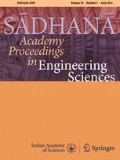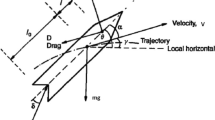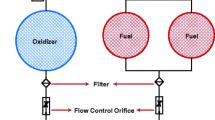Abstract
A deceleration system consisting of staged parachute clusters and retro thrusters is optimized for the recovery of the first stage of a launch vehicle on sea. Optimal mass as well as reduction in speed by each parachute cluster and the retro thrusters is essential to minimize the inherent payload loss due to inclusion of additional systems. Three disciplines are involved in the study, namely parachute design, grain design and Three Degrees of Freedom (3-DOF) trajectory simulations. Parachute components are sized and their masses are estimated using a parachute design code. It computes the number of parachutes in the cluster, their sizes and opening loads for multiple reefing stages. Solid motor grain design is carried out, using high burn rate propellant, to provide high thrust to decelerate the launch vehicle stage to a near-zero descent rate at touchdown. A Multiobjective Multidisciplinary Design Optimization (\(\text{M}^{2}\)DO) problem has been formulated to minimize the mass of the deceleration system and minimize the touchdown speed of the recovered stage, subject to constraints on Maximum Expected Operating Pressure (MEOP), feasibility, etc. The optimization is carried out and the Pareto optimal front is obtained using an in-house multi-objective optimization algorithm, Attractor Anchored Multi-objective Evolutionary Algorithm (A\(^2\)-MOEA). A total of twenty-five design variables are considered including initial conditions for each deceleration stage, size of parachute cluster components for both drogue and main parachutes, and the size and shape of the solid motor grain for retro rockets. It is seen that the two objectives are conflicting. The Pareto optimal designs are discussed and the variation of design variables is presented.






Similar content being viewed by others
Abbreviations
- 3-DOF:
-
Three Degrees of Freedom
- \(\text{A}^{2}\)-MOEA:
-
Attractor Anchored Multi-objective Evolutionary Algorithm
- BINC:
-
Ballistic Incremental Analysis Code
- CG:
-
Center of Gravity
- DF:
-
Design Factor
- EAS:
-
Equivalent Air Speed
- ECI:
-
Earth Centered Inertial
- GA:
-
Genetic Algorithm
- IDF:
-
Individual Discipline Feasible
- \(\text{M}^{2}\)DO:
-
Multiobjective Multidisciplinary Design Optimization
- MDO:
-
Multidisciplinary Design Optimization
- MEOP:
-
Maximum Expected Operating Pressure
- MOEA:
-
Multi-objective Evolutionary Algorithm
- NLP:
-
Non-linear Programming Problem
- P-R-F:
-
Parachute-Retro-Float
- ParDAC:
-
Parachute Design and Analysis Code
- TRL:
-
Technology Readiness Level
- VARF:
-
Velocity Aligned Reference Frame
- \(\phi \) :
-
Elevation Angle, Latitude (rad)
- \(\gamma \) :
-
Flight Path Angle (rad)
- \(\theta \) :
-
Longitude (rad)
- \(\theta ^{T}\) :
-
Angle between thrust vector and the velocity vector (deg)
- \(\omega \) :
-
Angular Velocity (rad/s)
- \(\psi \) :
-
Heading Angle (rad)
- \(\sigma \) :
-
Bank Angle for lift (deg)
- \(\sigma ^{T}\) :
-
Bank Angle for thrust (deg)
- \(\eta \) :
-
Opening profile shape exponent
- \(\mu \) :
-
Design load
- \(\mu ^{l}\) :
-
Design load per unit length
- \(C_{D}S\) :
-
Drag area
- \({C_{D_{0}}}\) :
-
Drag coefficient defined with respect to area corresponding to nominal diameter
- \({C_{D_{0,\ ROD}}}\) :
-
\({C_{D_{0}}}\) at a particular rate of descent
- \(C_{X}\) :
-
Opening force coefficient at infinite mass (dimensionless)
- D :
-
Diameter
- \(D_{0}\) :
-
Nominal diameter
- \(D_{0,max}\) :
-
Maximum allowable diameter of a parachute in a cluster
- \(D_{e}\) :
-
Nozzle exit diameter
- \({{\Delta }N}_{lobe,int}\) :
-
Penalty for non-integer value of the number of lobes
- \({{\mathcal {F} C_{D_{0,\ \frac{L_e}{D_0}}}}}\) :
-
Factor indicating drag augmentation due to increase in \({\frac{{Le}}{{D0}}}\). It is 1 when \({\frac{{Le}}{{D0}}\ =\ 1}\)
- \({\mathcal {F} C_{D_{0,\ N}}}\) :
-
Factor indicating drag reduction due to parachute clustering. It is one when number of parachutes in cluster is 1
- \(\mathcal {V}\) :
-
Equivalent Air Speed
- \(\Delta _{retro}\) :
-
Indicates feasiblity of sustainable combustion inside the retro motors
- \(\Delta _{drogue}\) :
-
Indicates feasibility of a parachute design
- \(\Delta _{main}\) :
-
Indicates feasibility of a parachute design
- \(D_{e,max}\) :
-
Maximum nozzle exit diameter
- \(D_{p}\) :
-
Projected diameter of parachute
- \(\text{F}\) :
-
Opening load
- \(\text{h}\) :
-
Height, m
- \(I_{SP}\) :
-
Specific Impulse, Ns/kg
- L :
-
Length
- \(L_{e}\) :
-
Length of suspension line
- m :
-
Mass, kg
- \(\dot{m}\) :
-
Mass flow rate of propellant (kg/s)
- \(C^{*}\) :
-
Characteristic velocity of the propellant
- \(n_{f}\) :
-
Number of objective functions
- \(n_{susp}\) :
-
Number of suspension lines
- P :
-
Penalty
- \(\text{q}\) :
-
Dynamic Pressure
- \(r_{p}\) :
-
Grain port radius
- r :
-
Radius (m)
- \({S_0}\) :
-
Reference area corresponding to \({D_0}\). \({S_0\ =\ \frac{\pi D_0^2}{4}}\)
- \({{\vec {s}}}\) :
-
The state vector \({\vec {s} = \{ r, \theta , \phi , V, \gamma , \psi \}}\)
- T :
-
Thrust, N
- t :
-
time, s
- \(t_{m}\) :
-
Filling time of a reefed stage
- \(t_{p}\) :
-
Pre-inflation time
- \(t_{y}\) :
-
Reefed time of a canopy reefing stage
- \(T_{L}\) :
-
Component of thrust along vehicle lift (N)
- \(T_{V}\) :
-
Component of thrust along vehicle velocity (N)
- V :
-
Speed (m/s)
- \(\text{W}\) :
-
Weight carried by canopy
- w :
-
weight
- \({\vec {X}}\) :
-
Design Variable
- X :
-
Force reduction factor (dimensionless)
- 1:
-
For drogue parachute
- 2:
-
For main parachute
- 3:
-
For retro firing
- cnpy :
-
Canopy
- coupling :
-
coupling
- drogue :
-
Drogue parachute
- est :
-
Estimated
- f :
-
Terminal
- i :
-
Initial
- main :
-
main parachute
- max :
-
Maximum value
- p :
-
Propellant
- rad :
-
Radial line
- retro :
-
retro rocket
- riser :
-
Riser
- sband :
-
Skirt band
- susp :
-
Suspension line
- vline :
-
Vent line
References
Xue Y, Yu L and Zhao X S 2017 Optimization of the reefed parachute using genetic algorithm. Engineering Computations 34.6 (2017): 1923–1938.
Leonard A et al 2017 Probabilistic algorithm for ballistic parachute transition altitude optimization. Journal of Guidance, Control, and Dynamics (2017): 1–13.
Brooks W T 1982 Ballistic optimization of the star grain configuration. Journal of Spacecraft and Rockets 19.1 (1982): 54–59.
Harrison E F and Slocumb Jr T H 1969 Evaluation of entry and terminal deceleration systems for unmanned Martian landers. Journal of Spacecraft and Rockets 6.10 (1969): 1109–1113.
Knacke T W 1991 Parachute recovery systems design manual. No. NWC-TP-6575, Naval Weapons Center China Lake, CA.
Mukunda H S and Paul P J 1997 Universal behavior in erosive burning of solid propellants. Combustion and Flame, vol. 109.
Priyadarshi P 2015 Multifidelity multiobjective multidisciplinary design optimization (\(M^3DO\)) of a semi-ballistic re-entry vehicle. PhD Thesis, IITK, Kanpur, India, December 2015.
Author information
Authors and Affiliations
Corresponding author
Rights and permissions
About this article
Cite this article
Priyadarshi, P., Joseph, L. & Saroha, K. Optimal two-stage parachute and retro motor sizing for launch vehicle stage recovery. Sādhanā 45, 241 (2020). https://doi.org/10.1007/s12046-020-01420-3
Received:
Revised:
Accepted:
Published:
DOI: https://doi.org/10.1007/s12046-020-01420-3




